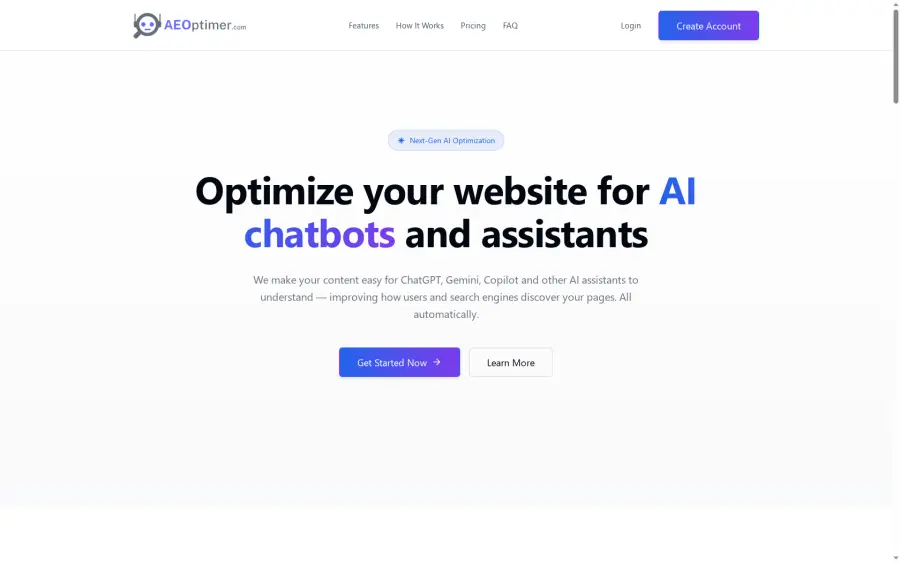How to Audit Website for AI: Step-by-Step Visibility Guide

More than 60 percent of websites miss out on AI-powered search traffic simply because their content is not optimized for artificial intelligence. Today, making your website accessible to AI systems is as critical as traditional SEO. If your site is not structured for AI analysis, you risk falling behind in search rankings and answer engine visibility. Learn practical steps to transform your website into an AI-friendly digital space that stands out in search results.
Table of Contents
- Step 1: Prepare Your Website For AI Analysis
- Step 2: Install Automated AI Audit Tools
- Step 3: Enable Structured Data And AI Enhancements
- Step 4: Review And Refine Content For AI Discoverability
- Step 5: Verify Ongoing AI Search Performance
Quick Summary
| Key Point | Explanation |
|---|---|
| 1. Prepare content for AI analysis | Ensure your website content is clear, descriptive, and organized for AI tools to easily evaluate it. |
| 2. Install automated AI audit tools | Choose tools that assess your website’s AI readiness, offering insights without requiring technical expertise. |
| 3. Implement structured data enhancement | Use schema markup and metadata to provide clear context for AI systems, improving discoverability. |
| 4. Continuously refine website content | Regularly audit and update your content to enhance clarity and relevance for AI comprehension. |
| 5. Monitor AI search performance regularly | Use analytics to track how AI interprets your content, making adjustments to improve visibility continuously. |
![]() |
|
Step 1: Prepare your website for AI analysis
Website preparation for AI analysis involves creating a digital environment that allows AI tools to easily understand and process your content. According to Drupal Harvard Sites, this requires strategic content structuring that enables seamless AI comprehension.
To prepare your website effectively, start by examining your existing content through an AI accessibility lens. This means ensuring your text is clear, descriptive, and logically organized. Key steps include writing precise page titles, crafting informative meta descriptions, and using proper heading hierarchies that guide AI systems through your website’s information architecture. As Student Guide to AI suggests, understanding AI capabilities helps you optimize content for better interaction.
One crucial recommendation is implementing structured data markup. This technical enhancement allows AI systems to quickly parse and understand your content’s context, improving both search engine optimization and answer engine optimization. Think of structured data like a translator that helps AI interpret your website’s meaning more accurately. By providing clear semantic signals, you make your website significantly more accessible to AI analysis tools.
Preparing your website for AI is not a one time task but an ongoing process of refinement and adaptation. The next step will involve detailed content analysis and strategic optimization techniques.
Step 2: Install automated AI audit tools
Installing automated AI audit tools is a critical step in comprehensively evaluating your website’s AI readiness and performance. AI Toolkit emphasizes the importance of selecting tools that promote transparency and enable comprehensive analysis of your digital content.
To begin the installation process, research and select AI audit tools that align with your specific website needs. Look for solutions that offer robust features such as content analysis, semantic structure evaluation, and AI discoverability scoring. As recommended by the Graduate School USA, pay close attention to tools that provide responsible auditing capabilities with privacy preserving mechanisms.
When installing these tools, prioritize platforms that offer seamless integration and minimal technical complexity. Automated AI audit tools should provide clear insights without requiring extensive technical expertise. Many modern solutions offer simple script installations or browser extensions that can quickly scan and assess your website’s AI compatibility. Making Websites AI Discoverable: Step-by-Step Guide can provide additional context for selecting the right auditing approach.
Remember that tool installation is just the beginning. Ongoing monitoring and periodic reassessment will be crucial for maintaining your website’s AI optimization strategy. The next phase will involve interpreting the audit results and implementing targeted improvements.

Step 3: Enable structured data and AI enhancements
Enabling structured data and AI enhancements transforms your website into a more intelligible and accessible digital platform for artificial intelligence systems. According to Drupal Harvard Sites, implementing strategic metatags and content structure is crucial for improving both search engine and answer engine optimization.
To begin enhancing your website, focus on implementing schema markup and semantic HTML elements that provide clear context for AI tools. This involves adding detailed metadata to your pages, using appropriate header tags, and ensuring your content has a logical hierarchical structure. Creating AI-Friendly Website Content offers insights into how these technical details can significantly improve your website’s AI discoverability.
As Student Guide to AI emphasizes, the goal is to make your digital content as transparent and interpretable as possible. Consider adding JSON-LD structured data to provide explicit information about your content type, author, publication date, and other relevant details. This helps AI systems quickly understand and categorize your website content. Pay special attention to image alt text, internal linking, and ensuring that your content provides clear semantic signals that AI can easily parse and comprehend.
Remember that structured data is an ongoing process of refinement. The next step will involve testing and validating your AI enhancements to ensure maximum effectiveness and discoverability.
Step 4: Review and refine content for AI discoverability
Reviewing and refining your website content for AI discoverability is a critical process that transforms your digital presence into an AI-friendly platform. Drupal Harvard Sites emphasizes the importance of maintaining clear, descriptive, and up-to-date content that helps AI systems accurately interpret and rank your website.
Begin by conducting a comprehensive content audit, focusing on clarity, relevance, and semantic structure. Analyze each page for precise language, logical organization, and meaningful headings that provide clear context. How to Update Website Content for AI Visibility Success suggests systematically evaluating your content to ensure it meets AI comprehension standards. Look for opportunities to simplify complex language, remove redundant information, and enhance the overall readability of your text.
According to the Student Guide to AI, understanding AI capabilities is crucial for effective content refinement. Pay special attention to your page titles, meta descriptions, and overall content flow. Ensure that each piece of content answers potential user queries directly and provides comprehensive information. Remove industry jargon, break down complex concepts, and use clear, concise language that AI systems can easily parse and understand.
Remember that content refinement is an ongoing process. The next step will involve implementing the changes and preparing for continuous monitoring and optimization.
Step 5: Verify ongoing AI search performance
Verifying ongoing AI search performance is essential for maintaining your website’s digital relevance and discoverability. Drupal Harvard Sites recommends a proactive approach to monitoring how AI systems interpret and rank your website content, focusing on regular updates and performance assessments.
To effectively track your AI search performance, implement a comprehensive monitoring strategy that includes multiple evaluation techniques. Use AI search tools and analytics platforms to assess your website’s visibility across different AI assistants and search engines. What Is AI Search? provides insights into understanding these complex evaluation metrics. Pay attention to key performance indicators such as answer placement, content extraction accuracy, and the frequency with which your website appears in AI generated responses.
According to the Student Guide to AI, continuous engagement and adaptation are crucial for maintaining AI search effectiveness. Regularly review your website’s performance by conducting test queries, analyzing AI interaction logs, and comparing your content visibility across different platforms. Look for patterns in how AI systems interpret your content, identify potential areas of improvement, and be prepared to make swift adjustments to your content strategy. This ongoing refinement process ensures that your website remains optimized for emerging AI search technologies.
Remember that AI search performance is dynamic. The next step involves creating a sustainable optimization strategy that keeps pace with evolving AI technologies.
Take Control of Your Website’s AI Visibility Today
Struggling to keep up with the complex steps of auditing your site for AI discoverability? From preparing your content to enabling structured data, the process can quickly become overwhelming when you factor in constant AI updates and search algorithm changes. You need a solution that handles all the technical heavy lifting automatically and ensures your website stays relevant in AI-driven search results.

Unlock the full potential of your website with aeoptimer.com. Our platform automates structured data implementation and monthly content enhancements so your site always meets the latest AI and search engine standards. No technical skills required. Ready to upgrade your AI search performance? Visit aeoptimer.com now and experience seamless, ongoing optimization that keeps your content visible across AI assistants like ChatGPT, Gemini, and Copilot. Don’t let your website fall behind—make your AI audit and optimization effortless today.
Frequently Asked Questions
How can I prepare my website for AI analysis?
To prepare your website for AI analysis, focus on structuring your content clearly and logically. Start by writing precise page titles and informative meta descriptions, then implement a proper heading hierarchy to facilitate understanding. This will make it easier for AI tools to process and analyze your site.
What are automated AI audit tools and how do I install them?
Automated AI audit tools are software designed to evaluate your website’s compatibility with AI technologies. To install them, research various options that offer content analysis and integration features, then follow their setup instructions, usually involving simple scripts or browser extensions.
What is structured data, and why is it important for AI visibility?
Structured data is a standardized format for providing information about a page and its content, helping AI systems understand and process data efficiently. Implement structured data tags such as schema markup to improve your website’s AI discoverability and clarity.
How do I review and refine my content for better AI discoverability?
To review and refine your content for AI discoverability, conduct a content audit focusing on clarity, readability, and semantic structure. Simplify complicated language and ensure your headings are meaningful, enabling AI systems to interpret and rank your content more accurately.
How can I monitor my website’s AI search performance effectively?
Monitor your website’s AI search performance by implementing a comprehensive strategy using analytics tools and tracking AI interaction metrics. Regularly assess key indicators like content extraction accuracy and adjust your content strategy based on observed patterns for continuous improvement.
What steps should I take if my website’s AI performance declines?
If your website’s AI performance declines, start by analyzing your content for areas that may need refinement based on AI comprehension standards. Adjust your content to enhance clarity and relevancy while also reviewing your structured data to ensure it aligns with current AI practices.





